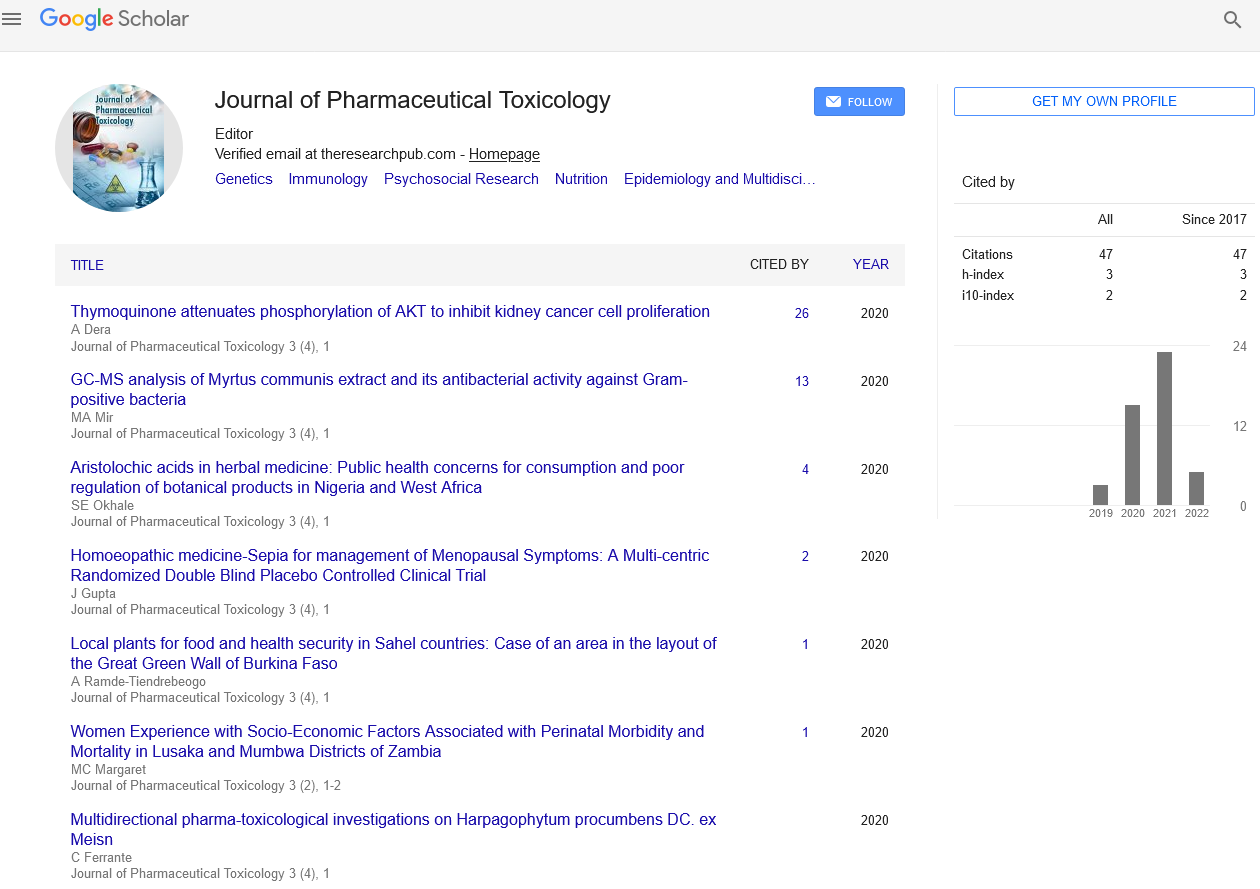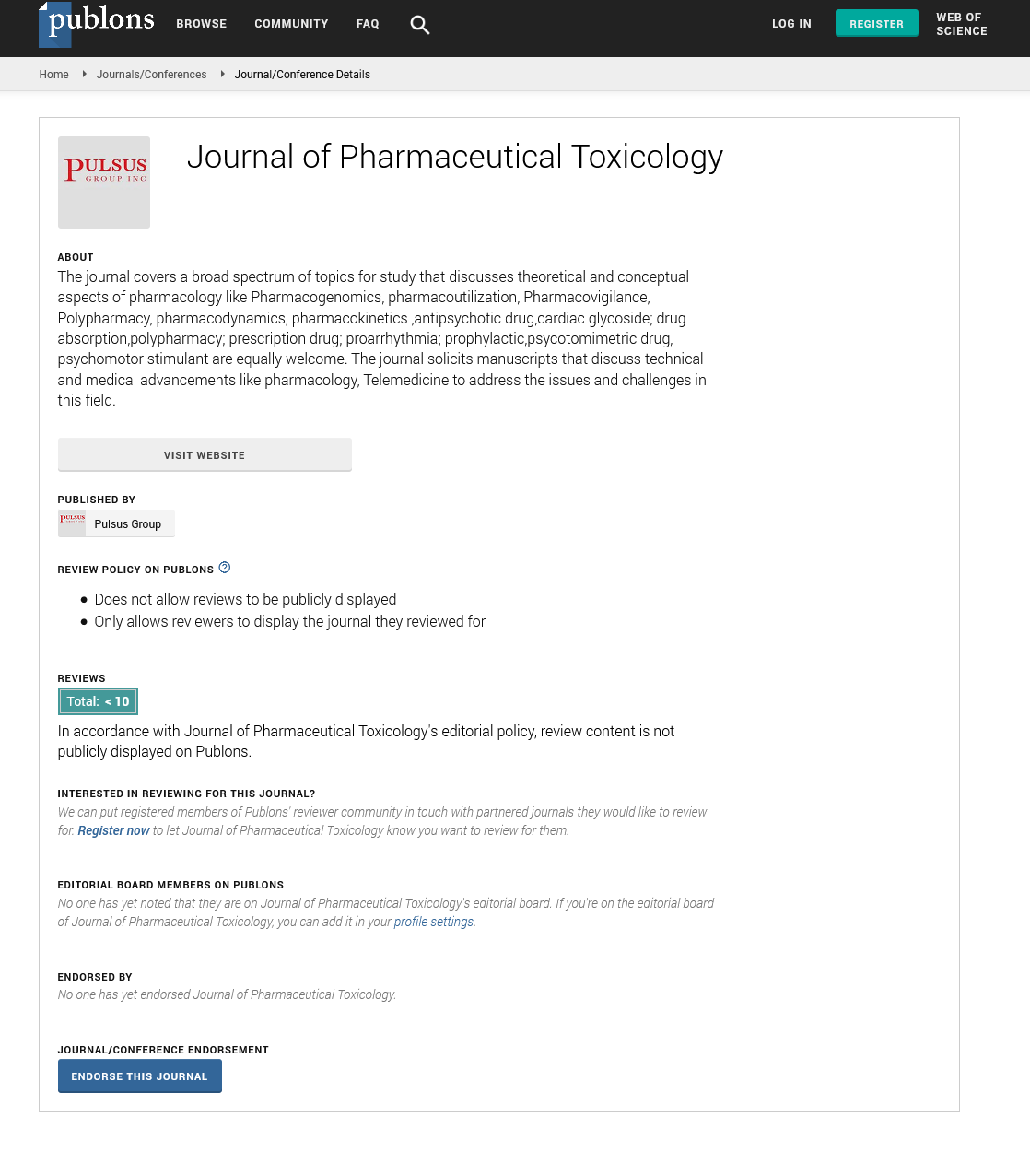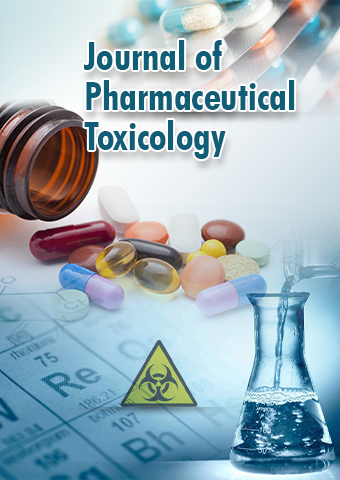Short Communication - Journal of Pharmaceutical Toxicology (2023) Volume 6, Issue 4
Pharmaceutical Industry Plays a Crucial Role in Healthcare
Uetani Wang*
Department of Medicine and Therapeutics, The Chinese University of Hong Kong, Prince of Wales Hospital, Shatin, Hong Kong, China
Department of Medicine and Therapeutics, The Chinese University of Hong Kong, Prince of Wales Hospital, Shatin, Hong Kong, China
E-mail: uetani.wang89@gmail.com
Received: 01-August-2023, Manuscript No. oajpt-23-108570; Editor assigned: 3- August -2023, PreQC No. oajpt-23-108570 (PQ); Reviewed: 17- August -2023, QC No. oajpt-23-108570; Revised: 22- August -2023, Manuscript No. oajpt-23-108570 (R); Published: 28- August -2023; DOI: 10.37532/ jpt.2023.6(4).113-114
Abstract
Pharmaceuticals, also known as drugs or medicines, are substances intended for use in the diagnosis, treatment, prevention, or relief of diseases or medical conditions in humans and animals. The pharmaceutical industry plays a crucial role in developing, producing, and distributing these medicinal products. Pharmaceutical companies invest significant time and resources in researching and developing new drugs. This process involves identifying potential drug candidates, conducting preclinical studies, and then proceeding to clinical trials to determine safety and efficacy in humans. Clinical trials are essential for assessing the safety and effectiveness of new drugs. These trials involve testing the drug on human volunteers in carefully controlled settings, following strict ethical guidelines and regulations.
Introduction
Regulatory Approval: Before a pharmaceutical product can be marketed and prescribed to patients, it must receive regulatory approval from health authorities like the U.S. Food and Drug Administration (FDA) or the European Medicines Agency (EMA). These agencies assess the data from clinical trials and other supporting evidence to ensure the drug’s safety and efficacy. Once a drug receives regulatory approval, pharmaceutical companies produce it on a large scale. They adhere to strict quality control standards to ensure consistency and safety in each batch. The drugs are then distributed to pharmacies, hospitals, and other healthcare facilities [1,2].
After the patent of a brand-name drug expires, other manufacturers can produce and sell generic versions of the drug. These generic drugs are required to meet the same quality and safety standards as the original brand-name product but often come at a lower cost. Some pharmaceutical products are available without a prescription and can be purchased directly by consumers. These are known as over-the-counter medications and are typically used to treat mild conditions or symptoms. Biopharmaceuticals are drugs derived from biological sources, such as proteins and antibodies. Biotechnology plays a significant role in the development of these advanced medicines, often used to target specific diseases or conditions [3-5].
Discussion
It’s important to note that the pharmaceutical industry is heavily regulated to ensure the safety and efficacy of drugs, as well as to protect consumers from potential risks. Pharmaceuticals have had a transformative impact on healthcare, significantly improving the treatment and management of various diseases and medical conditions. The pharmaceutical industry plays a crucial role in healthcare, as it contributes to the development of new treatments, vaccines, and medications that improve the quality of life and prolong the lives of millions of people worldwide. However, it also faces challenges related to high research and development costs, lengthy approval processes, and issues surrounding drug pricing and access. Pharmaceuticals, also known as drugs or medications, are substances used to diagnose, treat, prevent, or cure diseases and medical conditions in humans and animals. The field of pharmaceuticals involves the research, development, production, and distribution of these substances [6,7].
Pharmaceutical companies invest significant resources in researching and developing new drugs. This process involves identifying potential drug targets, screening and testing compounds for efficacy and safety, and conducting pre-clinical studies before moving on to human clinical trials.
Before a new drug can be approved for use by regulatory authorities, it must undergo clinical trials. These trials involve testing the drug on human volunteers to determine its safety, effectiveness, and potential side effects. Clinical trials typically have multiple phases, with an increasing number of participants in each phase.
Drug approval and regulation: Once clinical trials are successfully completed and data is submitted, regulatory agencies such as the U.S. Food and Drug Administration (FDA) in the United States or the European Medicines Agency (EMA) in Europe review the data to assess whether the drug is safe and effective for its intended use. If approved, the drug can be marketed and distributed to the public. Once a drug is approved, pharmaceutical companies produce it on a large scale to meet demand. The drugs are then distributed through pharmacies, hospitals, and other healthcare facilities for patient use [8,9].
After the patent on a brand-name drug expires, other companies can produce and sell generic versions of the drug. Generic drugs are equivalent in terms of active ingredients, dosage, and effectiveness, but they are typically sold at lower prices. Over-the-Counter (OTC) Drugs: Some medications are available without a prescription and can be purchased directly by consumers from pharmacies or stores. These are known as over-the-counter (OTC) drugs and are typically used to treat common, mild ailments. Pharmaceuticals play a crucial role in modern medicine, helping to improve and prolong the lives of millions of people around the world. However, they must be used responsibly and under the guidance of healthcare professionals to ensure safety and effectiveness [10].
Conclusion
Drug Approval and Regulation: Once clinical trials are successfully completed and data is submitted, regulatory agencies such as the U.S. Food and Drug Administration (FDA) in the United States or the European Medicines Agency (EMA) in Europe review the data to assess whether the drug is safe and effective for its intended use. If approved, the drug can be marketed and distributed to the public. Once a drug is approved, pharmaceutical companies produce it on a large scale to meet demand. The drugs are then distributed through pharmacies, hospitals, and other healthcare facilities for patient use. These are known as over-the-counter medications and are typically used to treat mild conditions or symptoms. Biopharmaceuticals are drugs derived from biological sources, such as proteins and antibodies. Biotechnology plays a significant role in the development of these advanced medicines, often used to target specific diseases or conditions.
References
- Saraswat A. Topical corticosteroid use in children: Adverse effects and how to minimize them.Indian J Dermatol Venereol Leprol.76, 225–228(2010).
- Beggs S. Paediatric analgesia.Aust Prescr.31, 63–65(2008).
- Rossi M, Giorgi G. Domperidone and long QT syndrome.Curr Drug Saf, 5, 257–262 (2010).
- Kosek M, Bern C, Guerrant RL. The global burden of diarrhoeal disease, as estimated from studies published between 1992 and 2000.Bull World Health Organ.81, 197–204(2003).
- Alam N, Najam R. Effect of repeated oral therapeutic doses of methylphenidate on food intake and growth rate in rats.Pak J Pharm Sci.28, 9–13(2015).
- Ryan C, Ross S, Davey P et al. Prevalence and causes of prescribing errors: The PRescribing Outcomes for Trainee Doctors Engaged in Clinical Training (PROTECT) study.PLoS ONE.9, 69-143(2006).
- Patrick DM, Marra F, Hutchinson J et al. Per capita antibiotic consumption: How does a North American jurisdiction compare with Europe? Clin Infect Dis. 39, 11-17 (2004).
- Li WC. Occurrence, sources, and fate of pharmaceuticals in aquatic environment and soil. Environ. Pollute. 187, 193-201 (2014).
- Heberer T. Occurrence, fate, and removal of pharmaceutical residues in the aquatic environment:A review of recent research data. Toxicol Lett. 131, 5-17 (2002).
- Banci L, Ciofi-Baffoni S, Tien M Lignin et al. Peroxidase-catalyzed oxidation of phenolic lignin oligomers. Biochemistry. 38, 3205-3210 (1999).
Indexed at, Google Scholar, Crossref
Indexed at, Google Scholar, Crossref
Indexed at, Google Scholar, Crossref
Indexed at, Google Scholar, Crossref
Indexed at, Google Scholar, Crossref


